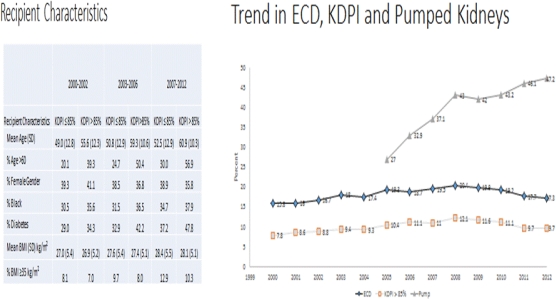Kidney Donor Profile Index Trend Analyses.
Surgery, Duke University Medical Center, Durham, NC.
Meeting: 2016 American Transplant Congress
Abstract number: 215
Keywords: Donors, Graft survival, Kidney transplantation, marginal
Session Information
Session Name: Concurrent Session: Kidney Transplantation: Allocation, Discard, and HCV
Session Type: Concurrent Session
Date: Monday, June 13, 2016
Session Time: 2:30pm-4:00pm
 Presentation Time: 2:54pm-3:06pm
Presentation Time: 2:54pm-3:06pm
Location: Veterans Auditorium
Introduction
In spite of improved outcomes associated with the usage of extended criteria donor (ECD) kidneys, the number of kidney transplants (KT) using this donor population (DP) have declined over time. Kidney donor profile index (KDPI) is a numerical measure (0 to 100%) that combines ten dimensions of information about a donor, including clinical parameters and demographics, to express the quality of the donor kidneys relative to other donors. KDPI is now used for organ allocation with a higher KDPI value associated with lower donor quality. A Donor KDPI >85% (DK85) is thought to be equivalent to an ECD kidney.
Objective:
Analyze the trends in usage and outcomes of KT associated with the KDPI.
Methods:
All adult recipients (>18) with deceased donor KTs between 2000 and 2012 were included in the study. The study period was chosen to reflect changes in allocation policy- ECD introduction in 2002 and CMS program evaluation started in 2007. We retrospectively calculated the KDPI for this DP. The trend analysis of the kidney transplant recipients based on KDPI was then carried out.
Results
92,935 KTs were performed during the study period. DK85 had increased incidence of diabetes, hypertension, higher BMI and DCD status. Even though the KDPI was relatively stable from 2000-2012, the % of delayed graft function was lower probably representing improved donor and recipient selection. The % of kidneys with machine perfusion has increased with time. Induction with lymphocyte depleting agents increased from 23.5% to 63.4%, with decreasing utilization of IL2 receptor antagonists (38.3% to23.6%) and corticosteroids (89% to 62.7%). The proportion of KDPI >85% transplants increased from 7.8 percent age in 2000 to 12.1% in 2008 and declined thereafter to 9.7% in 2012 (Figure 1). The 5 year graft survival also improved from for 49.8% to 56.1% over the study period.

Conclusions:
Although kidney transplant outcomes with DK85 have improved over time, utilization of DK85 shows a downward trend. Further studies will help to assess the impact of improved organ selection (by kidney biopsy findings and machine perfusion) and increased use of lymphocyte depletion agents.
CITATION INFORMATION: Vikraman D, Ravindra K, Sanoff S, Irish W, Patel U, Sudan D. Kidney Donor Profile Index Trend Analyses. Am J Transplant. 2016;16 (suppl 3).
To cite this abstract in AMA style:
Vikraman D, Ravindra K, Sanoff S, Irish W, Patel U, Sudan D. Kidney Donor Profile Index Trend Analyses. [abstract]. Am J Transplant. 2016; 16 (suppl 3). https://atcmeetingabstracts.com/abstract/kidney-donor-profile-index-trend-analyses/. Accessed December 16, 2025.« Back to 2016 American Transplant Congress
